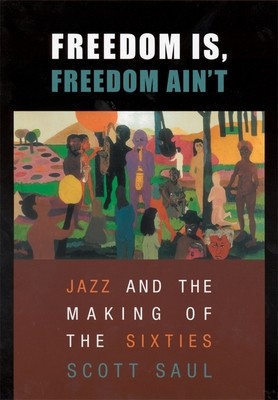
- We will send in 10–14 business days.
- Author: Scott Saul
- Publisher: Harvard University Press
- ISBN-10: 0674018532
- ISBN-13: 9780674018532
- Format: 14.6 x 23.1 x 2.8 cm, softcover
- Language: English
- SAVE -10% with code: EXTRA
Reviews
Description
In the long decade between the mid-fifties and the late sixties, jazz was changing more than its sound. The age of Max Roach's Freedom Now Suite, John Coltrane's A Love Supreme, and Charles Mingus's The Black Saint and the Sinner Lady was a time when jazz became both newly militant and newly seductive, its example powerfully shaping the social dramas of the Civil Rights movement, the Black Power movement, and the counterculture. Freedom Is, Freedom Ain't is the first book to tell the broader story of this period in jazz--and American--history. The story's central figures are jazz musicians like Coltrane and Mingus, who rewrote the conventions governing improvisation and composition as they sought to infuse jazz with that gritty exuberance known as soul. Scott Saul describes how these and other jazz musicians of the period engaged in a complex cultural balancing act: utopian and skeptical, race-affirming and cosmopolitan, they tried to create an art that would make uplift into something forceful, undeniable in its conviction, and experimental in its search for new possibilities. Freedom Is, Freedom Ain't considers these musicians and their allies as a cultural front of the Civil Rights movement, a constellation of artists and intellectuals whose ideas of freedom pushed against a cold-war consensus that stressed rational administration and collective security. Capturing the social resonance of the music's marriage of discipline and play, the book conveys the artistic and historical significance of the jazz culture at the start, and the heart, of the sixties.
EXTRA 10 % discount with code: EXTRA
The promotion ends in 16d.03:24:23
The discount code is valid when purchasing from 10 €. Discounts do not stack.
- Author: Scott Saul
- Publisher: Harvard University Press
- ISBN-10: 0674018532
- ISBN-13: 9780674018532
- Format: 14.6 x 23.1 x 2.8 cm, softcover
- Language: English English
In the long decade between the mid-fifties and the late sixties, jazz was changing more than its sound. The age of Max Roach's Freedom Now Suite, John Coltrane's A Love Supreme, and Charles Mingus's The Black Saint and the Sinner Lady was a time when jazz became both newly militant and newly seductive, its example powerfully shaping the social dramas of the Civil Rights movement, the Black Power movement, and the counterculture. Freedom Is, Freedom Ain't is the first book to tell the broader story of this period in jazz--and American--history. The story's central figures are jazz musicians like Coltrane and Mingus, who rewrote the conventions governing improvisation and composition as they sought to infuse jazz with that gritty exuberance known as soul. Scott Saul describes how these and other jazz musicians of the period engaged in a complex cultural balancing act: utopian and skeptical, race-affirming and cosmopolitan, they tried to create an art that would make uplift into something forceful, undeniable in its conviction, and experimental in its search for new possibilities. Freedom Is, Freedom Ain't considers these musicians and their allies as a cultural front of the Civil Rights movement, a constellation of artists and intellectuals whose ideas of freedom pushed against a cold-war consensus that stressed rational administration and collective security. Capturing the social resonance of the music's marriage of discipline and play, the book conveys the artistic and historical significance of the jazz culture at the start, and the heart, of the sixties.


Reviews